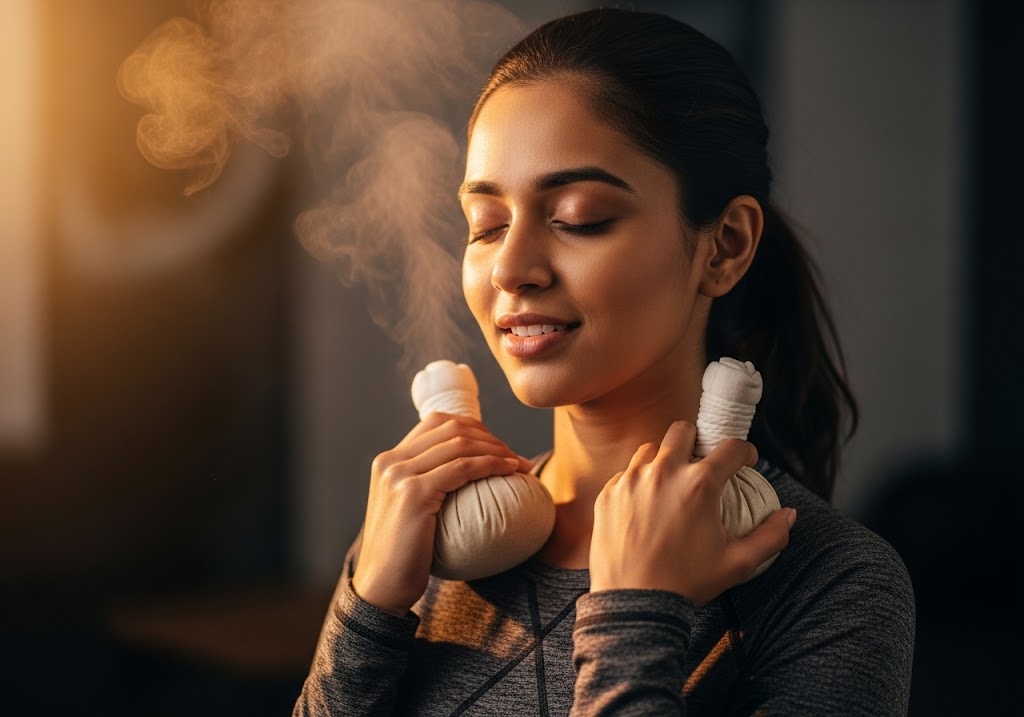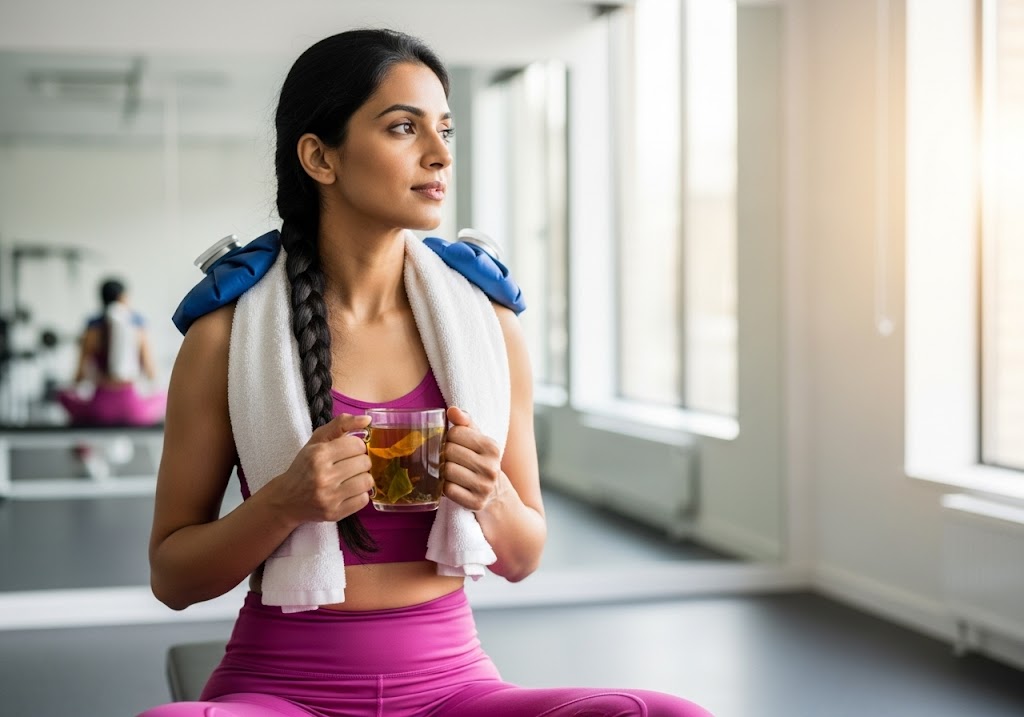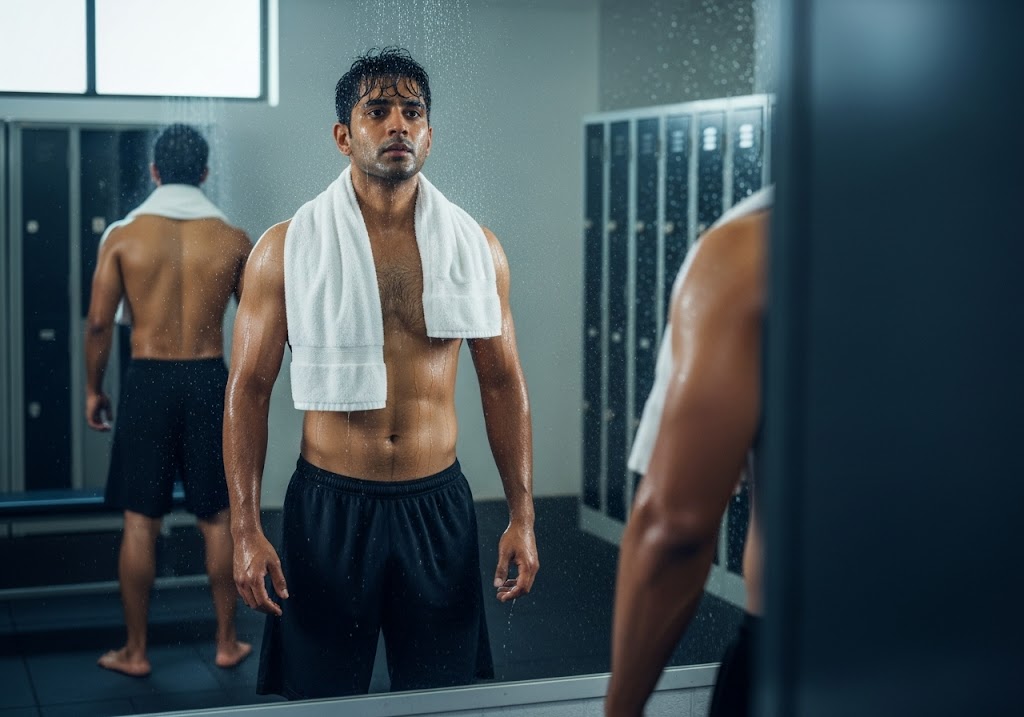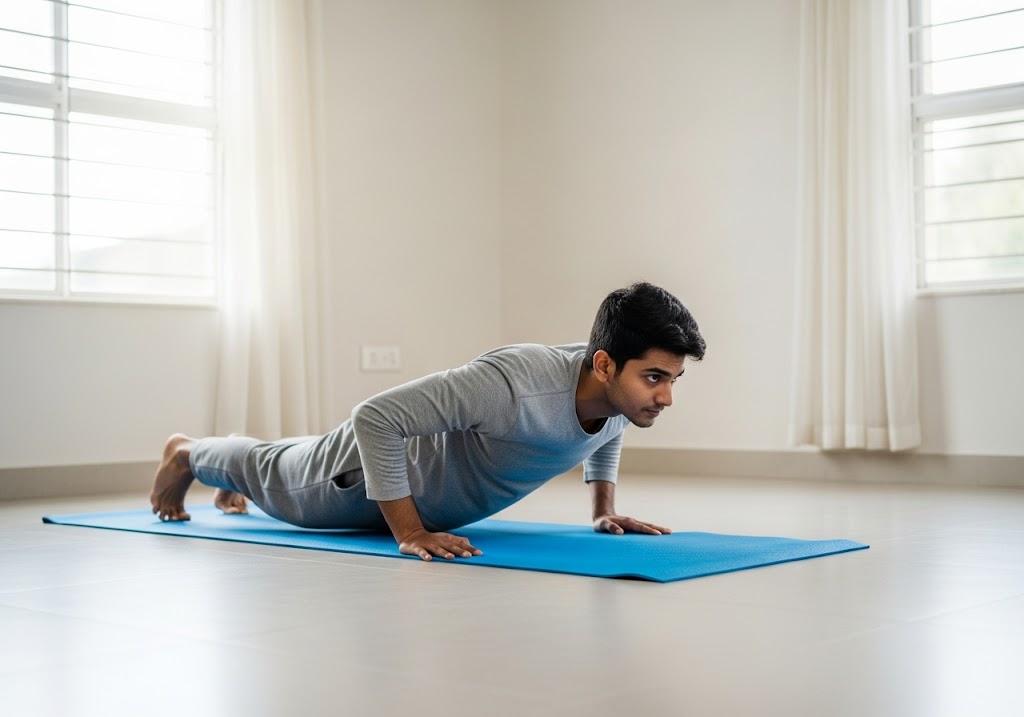Key differences in cold shower vs hot shower are: Cold showers excel for muscle recovery, inflammation reduction, and energy boost, while hot showers are superior for relaxation, sleep preparation, and stress relief – choose based on your specific health goals and timing.
Cold showers can help reduce inflammation, relieve pain, improve circulation, lower stress levels, and reduce muscle soreness and fatigue. Hot showers, meanwhile, can improve cardiovascular health, soothe stiff joints, and improve sleep quality. Understanding the cold shower vs hot shower debate helps you choose the right temperature for your specific health goals, workout recovery needs, and daily wellness routine.
Want to know which approach works best for your lifestyle and fitness goals? The cold shower vs hot shower comparison reveals that both temperatures offer unique health benefits that serve different purposes. Whether you’re seeking muscle recovery after intense training, improved circulation, better sleep, or enhanced mental alertness, this complete comparison covers everything you need to make informed decisions about your daily shower routine.
Table of Contents
Cold Shower Benefits
Cold shower benefits extend far beyond simple temperature preference, offering scientifically-proven advantages for physical and mental health. Understanding these benefits in the cold shower vs hot shower comparison helps you harness the power of cold water therapy for improved wellness and performance.
- Reduced Inflammation: Cold water constricts blood vessels, reducing inflammatory responses and swelling throughout the body
- Enhanced Circulation: Cold exposure forces blood to flow more efficiently, improving cardiovascular health and oxygen delivery
- Improved Muscle Recovery: Cold temperatures help reduce muscle soreness and accelerate recovery after intense physical activity
- Boosted Immune System: Regular cold exposure strengthens immune responses and increases white blood cell production
- Increased Alertness: Cold water triggers the release of norepinephrine, improving focus and mental clarity instantly
- Fat Burning Activation: Cold exposure activates brown fat tissue, which burns calories to generate heat for the body
- Stress Resilience: Cold therapy builds mental toughness and improves stress response through controlled exposure
- Better Skin and Hair: Cold water tightens pores, reduces oil production, and makes hair appear shinier and healthier
The cold water vs hot water shower choice for health benefits clearly favors cold water for inflammation reduction and metabolic improvements. These benefits make cold showers particularly valuable for athletes and fitness enthusiasts.
For those beginning their fitness journey, understanding how to start calisthenics can complement the recovery benefits of cold water therapy.
Hot Shower Benefits
Hot shower benefits provide compelling reasons to choose warm water for relaxation, circulation, and overall comfort. The hot shower vs cold shower after workout debate shows that hot water offers unique advantages that cold water cannot match for certain health goals.
| Benefit Category | Hot Shower Advantage | Mechanism | Best Timing |
|---|---|---|---|
| Muscle Relaxation | Superior tension relief | Heat dilates blood vessels | After long workdays |
| Sleep Quality | Improved sleep onset | Body temperature regulation | 1-2 hours before bed |
| Joint Pain Relief | Reduces stiffness | Increased blood flow | Morning or evening |
| Respiratory Health | Clears congestion | Steam opens airways | When feeling congested |
| Stress Relief | Mental relaxation | Activates parasympathetic system | High stress periods |
| Skin Hydration | Opens pores for cleansing | Heat softens skin | Daily maintenance |
Hot water benefits shine in relaxation and comfort scenarios, making them ideal for evening routines and stress management. The showering with hot water vs cold water decision depends largely on your immediate goals and physical needs.
However, hot showers also improve cardiovascular health through vasodilation, which increases blood flow and can help lower blood pressure temporarily. The warmth soothes stiff joints and muscles, making hot showers particularly beneficial for older adults or those with arthritis.
Explore the benefits of Somatic Pilates for improved posture, pain relief, and full-body awareness.

Cold Shower vs Hot Shower After Workout
The cold shower vs hot shower after workout decision significantly impacts your recovery, muscle adaptation, and overall training results. Understanding when to use each temperature optimizes your post-exercise routine for maximum benefits and faster recovery between training sessions.
| Aspect | Cold Shower After Workout | Hot Shower After Workout | Impact |
|---|---|---|---|
| Inflammation | Reduces inflammatory markers | May increase inflammation | Cold wins |
| Muscle Soreness | Significantly decreases DOMS | Limited soreness relief | Cold superior |
| Recovery Time | Accelerates recovery process | Slower recovery timeline | Cold advantage |
| Circulation | Improves via vasoconstriction | Enhances through vasodilation | Both beneficial |
| Mental State | Increases alertness, energy | Promotes relaxation, calm | Goal dependent |
| Sleep Quality | May interfere if too late | Improves sleep preparation | Hot for evening |
| Muscle Tension | Limited tension relief | Excellent muscle relaxation | Hot superior |
| Joint Relief | Minimal joint benefits | Superior joint pain relief | Hot advantage |
For intense training sessions that benefit from proper recovery, hiit workout in mumbai provides high-intensity routines that pair well with strategic temperature therapy.
Best Temperature for Showering
Determining the best temperature for showering in the cold shower vs hot shower debate depends on your specific goals, timing, and individual tolerance levels. Most health experts recommend a balanced approach that incorporates both temperatures strategically throughout your routine.
The optimal shower temperature typically ranges between 98-100°F (37-38°C) for general hygiene and comfort. However, therapeutic benefits emerge when you deliberately choose colder or hotter temperatures for specific purposes in your daily routine.
| Temperature Range | Purpose | Benefits | Duration | Best For |
|---|---|---|---|---|
| Cold (50-60°F) | Recovery, Alertness | Anti-inflammatory, metabolic | 2-5 minutes | Post-workout, morning |
| Cool (70-80°F) | Skin health, circulation | Gentle stimulation | 5-10 minutes | Daily maintenance |
| Warm (90-100°F) | Comfort, hygiene | Balanced cleansing | 10-15 minutes | Regular bathing |
| Hot (100-110°F) | Relaxation, therapeutic | Muscle relief, stress | 10-20 minutes | Evening, recovery |
The cold vs hot showers choice should align with your daily schedule and wellness goals. Morning cold showers energize and prepare you for the day, while evening hot showers promote relaxation and better sleep quality.
For comprehensive fitness routines that benefit from proper recovery, exploring full body calisthenics workout provides excellent training options that pair well with temperature therapy.

Benefits of Cold Shower After Workout
Cold showers after exercise provide specific advantages that support muscle recovery and adaptation through anti-inflammatory mechanisms. The cold water vs hot water shower decision for post-workout recovery clearly favors cold temperatures for inflammation control and enhanced recovery processes.
- Reduced Inflammation: Cold water constricts blood vessels, limiting inflammatory responses and reducing swelling in exercised muscles
- Decreased Muscle Soreness: Vasoconstriction helps flush metabolic waste products while reducing delayed onset muscle soreness significantly
- Accelerated Recovery: Cold exposure triggers norepinephrine release, acting as natural anti-inflammatory and enhancing recovery processes
- Improved Circulation: Cold water forces blood to circulate more efficiently, improving oxygen and nutrient delivery to tissues
- Enhanced Mental Clarity: Cold exposure increases alertness and mood through neurotransmitter activation post-exercise
- Reduced Muscle Damage: Cold therapy limits secondary muscle damage that occurs hours after intense exercise sessions
- Better Adaptation: Cold exposure may enhance training adaptations by reducing excessive inflammatory responses to exercise
For comprehensive back development that benefits from cold therapy recovery, calisthenics back exercises provides excellent training options.
Benefits of Hot Shower After Workout
Hot showers after exercise offer different advantages, particularly for muscle relaxation and circulation improvement through vasodilation mechanisms. The hot shower vs cold shower after workout debate shows that hot water excels in specific recovery scenarios and comfort applications.
- Superior Muscle Relaxation: Heat penetrates deep into muscle tissue, relieving tension and stiffness from intense training sessions
- Enhanced Blood Flow: Vasodilation increases circulation, delivering nutrients and oxygen needed for muscle repair and recovery
- Joint Pain Relief: Heat therapy reduces joint stiffness and pain, particularly beneficial for individuals with arthritis or chronic conditions
- Stress Reduction: Hot water activates the parasympathetic nervous system, promoting relaxation and reducing cortisol levels effectively
- Improved Sleep Preparation: Evening hot showers help regulate body temperature for better sleep quality and recovery
- Better Flexibility: Heat increases tissue pliability, making post-workout stretching more effective and comfortable
- Respiratory Benefits: Steam from hot water can help clear airways and improve breathing after intense cardio sessions
For building the strength foundation that supports recovery, basic calisthenics workout provides essential exercises that pair well with temperature therapy.
For intense training sessions that benefit from proper recovery, hiit workout in mumbai provides high-intensity routines that pair well with strategic temperature therapy.

Cold Shower vs Hot Shower for Hair
The cold shower vs hot shower for hair debate reveals significant differences in how water temperature affects hair health, appearance, and scalp condition. Understanding these differences helps you choose the optimal temperature for maintaining healthy, attractive hair.
Cold water benefits for hair include sealing the hair cuticle, which makes hair appear shinier and smoother while reducing frizz and tangles. Cold water also helps preserve natural oils that keep hair healthy and moisturized, preventing excessive dryness and breakage.
| Hair Aspect | Cold Water Benefits | Hot Water Effects | Recommendation |
|---|---|---|---|
| Shine | Seals cuticles for glossy finish | Opens cuticles, reduces shine | Cold water rinse |
| Frizz Control | Smooths hair shaft | Increases frizz and tangles | Cold water preferred |
| Oil Production | Preserves natural oils | Strips natural oils | Cold for oily hair |
| Scalp Health | Improves circulation | Can cause dryness/irritation | Moderate temperature |
| Color Retention | Helps preserve hair color | Fades color faster | Cold for colored hair |
| Volume | Adds natural body | Can flatten hair | Depends on hair type |
For beginners looking to start their fitness journey alongside temperature therapy, how to start calisthenics provides excellent foundational training approaches.
What About Contrast Temperature Therapy After Exercise?
Contrast temperature therapy combines both hot and cold water exposure in the cold shower vs hot shower after workout discussion. This technique alternates between hot and cold temperatures to maximize recovery benefits from both thermal extremes.
The contrast shower method typically involves 3-4 minutes of hot water followed by 30-60 seconds of cold water, repeated 3-4 times and ending with cold water. This approach stimulates circulation through vasodilation and vasoconstriction cycles.
Contrast Shower Protocol
Effective contrast therapy requires specific timing and temperature guidelines for optimal results in your post-exercise recovery routine.
| Phase | Temperature | Duration | Purpose | Repetitions |
|---|---|---|---|---|
| Hot | 100-104°F | 3-4 minutes | Vasodilation, relaxation | 3-4 cycles |
| Cold | 50-60°F | 30-60 seconds | Vasoconstriction, recovery | 3-4 cycles |
| Final | Cold | 1-2 minutes | End with vasoconstriction | 1 time |
For comprehensive recovery strategies, exploring advanced calisthenics routine provides training methods that benefit from proper temperature therapy protocols.
What Are the Best Ways to Recover After Exercise?
Understanding the best recovery methods helps contextualize where the cold shower vs hot shower decision fits into comprehensive post-exercise care. Temperature therapy represents just one component of effective recovery strategies.
Recovery encompasses multiple modalities that work synergistically to restore function, reduce soreness, and prepare your body for subsequent training sessions. The cold vs hot shower after workout choice should complement other recovery practices.
| Recovery Method | Primary Benefit | Timing | Duration | Effectiveness |
|---|---|---|---|---|
| Temperature Therapy | Inflammation control | Immediately after | 5-15 minutes | High |
| Proper Nutrition | Muscle repair | Within 2 hours | Ongoing | Very High |
| Adequate Sleep | Growth hormone release | Nightly | 7-9 hours | Very High |
| Active Recovery | Blood flow improvement | Next day | 20-30 minutes | Moderate |
| Stretching/Mobility | Flexibility maintenance | Post-workout | 10-15 minutes | Moderate |
| Hydration | Fluid balance | Throughout day | Ongoing | High |
The most effective recovery protocols combine multiple approaches rather than relying solely on temperature therapy. However, the strategic use of cold or hot water can significantly enhance your body’s natural recovery processes.
Proper nutrition timing proves crucial for recovery, and understanding intermittent fasting plan can help optimize nutrient timing around training sessions while supporting temperature therapy benefits.

Does It Matter Whether You Take a Hot or Cold Shower After a Workout?
The question of whether it matters in the cold shower vs hot shower after workout debate has a clear answer: yes, it significantly matters for optimizing recovery and training adaptations. The temperature you choose affects physiological processes that impact how quickly you recover and adapt to exercise.
Cold water exposure immediately post-exercise triggers specific recovery mechanisms that hot water cannot provide. The anti-inflammatory response from cold exposure helps limit muscle damage while promoting faster recovery between training sessions.
Conversely, hot water provides relaxation benefits and circulation improvements that cold water cannot match. The choice depends on your training goals, recovery needs, and individual response to temperature therapy.
| Scenario | Recommended Temperature | Reason | Expected Outcome |
|---|---|---|---|
| High-intensity training | Cold shower | Reduce inflammation | Faster recovery |
| Endurance exercise | Contrast therapy | Balance recovery needs | Optimal circulation |
| Strength training | Cold shower | Limit muscle damage | Reduced soreness |
| Light exercise | Hot shower | Promote relaxation | Stress relief |
| Multiple daily sessions | Cold shower | Rapid recovery | Better performance |
| Evening workouts | Hot shower | Prepare for sleep | Better rest quality |
The timing of your workout also influences the optimal choice in the cold shower vs hot shower decision. Evening exercisers might benefit more from hot showers to promote sleep, while morning exercisers often prefer cold water for continued alertness.
Take your bodyweight training to the next level with this advanced calisthenics routine built for strength, control, and skill.
How to Decide Between a Hot or Cold Shower After a Workout
Making the right choice in the cold shower vs hot shower after workout decision requires considering multiple factors including training intensity, time of day, personal goals, and individual tolerance levels for optimal recovery strategy implementation.
| Decision Factor | Choose Cold Shower | Choose Hot Shower | Considerations |
|---|---|---|---|
| Workout Intensity | High intensity training | Low-moderate intensity | Inflammation levels vary |
| Training Type | Strength, HIIT, intense cardio | Yoga, light cardio, stretching | Recovery needs differ |
| Time of Day | Morning or afternoon sessions | Evening workouts | Sleep impact varies |
| Recovery Goals | Reduce soreness, speed recovery | Relaxation, stress relief | Primary objective matters |
| Individual Tolerance | High cold tolerance | Low cold tolerance | Personal comfort important |
| Available Time | Quick recovery needed | Extended relaxation time | Time constraints matter |
| Upcoming Activities | Need alertness, energy | Preparing for rest/sleep | Next activity influences choice |
| Joint Issues | Minimal joint problems | Arthritis, stiffness present | Existing conditions matter |
For advanced training routines that benefit from strategic recovery, advanced calisthenics routine provides challenging workouts that pair well with temperature therapy.

Cold Water vs Hot Water Shower for Different Health Goals
The cold water vs hot water shower choice varies significantly based on specific health objectives and desired outcomes. Understanding how each temperature supports different goals helps you make informed decisions for your wellness routine.
Mental health benefits differ dramatically between temperature choices. Cold water exposure increases alertness and can help combat depression through neurotransmitter activation, while hot water promotes relaxation and stress relief through parasympathetic nervous system activation.
| Health Goal | Optimal Choice | Primary Mechanism | Additional Benefits |
|---|---|---|---|
| Weight Loss | Cold shower | Brown fat activation | Increased metabolism |
| Muscle Recovery | Cold shower | Anti-inflammatory | Reduced soreness |
| Sleep Quality | Hot shower | Temperature regulation | Relaxation response |
| Mental Alertness | Cold shower | Norepinephrine release | Improved focus |
| Stress Relief | Hot shower | Parasympathetic activation | Muscle relaxation |
| Circulation | Both/Contrast | Vascular training | Heart health |
| Immune Function | Cold shower | Stress adaptation | Increased resilience |
| Joint Health | Hot shower | Increased blood flow | Pain relief |
Cardiovascular health benefits also vary between temperatures. Cold exposure provides acute cardiovascular stress that can improve heart health over time, while hot water offers immediate circulation benefits and blood pressure reduction.
For comprehensive health approaches that complement temperature therapy, exploring calisthenics diet chart provides nutritional strategies for optimal wellness and recovery support.
Scientific Research on Cold Shower vs Hot Shower
Scientific research provides compelling evidence for both sides of the cold shower vs hot shower debate, with studies showing distinct physiological responses to different water temperatures. Understanding this research helps you make evidence-based decisions about your shower routine.
Cold water immersion studies consistently show reduced inflammation markers, improved immune function, and enhanced recovery following exercise. Research indicates that cold exposure for 2-5 minutes can provide significant anti-inflammatory benefits without negative side effects.
Hot water research demonstrates improved circulation, muscle relaxation, and sleep quality benefits. Studies show that hot bathing before bedtime can improve sleep onset and quality through thermoregulatory mechanisms.
Key Research Findings
Cold Water Studies:
- 11% increase in metabolism after cold exposure
- 30% reduction in muscle soreness post-exercise
- Improved immune markers after 6 weeks of cold showers
- Enhanced mood and reduced depression symptoms
Hot Water Studies:
- 15-20% improvement in circulation after hot bathing
- Better sleep quality when timed 1-2 hours before bed
- Reduced joint stiffness in arthritis patients
- Lower cortisol levels after warm water exposure
The research clearly supports both temperatures for different applications, reinforcing that the cold shower vs hot shower choice should be goal-specific rather than universally applied.
For building the foundation strength that benefits from proper recovery, basic calisthenics workout provides essential exercises that pair well with temperature therapy.
Practical Tips for Cold Shower vs Hot Shower Implementation
Successfully implementing the optimal temperature choice in your cold shower vs hot shower routine requires gradual adaptation and proper technique. These practical guidelines help you maximize benefits while minimizing discomfort during the transition period.
| Implementation Aspect | Cold Shower Tips | Hot Shower Tips | Success Factors |
|---|---|---|---|
| Starting Temperature | Begin with lukewarm, gradually decrease | Start moderate, increase slowly | Gradual adaptation prevents shock |
| Duration Progression | Start 30 seconds, build to 5 minutes | Begin 5 minutes, extend to 15 | Progressive exposure builds tolerance |
| Breathing Technique | Deep, controlled breaths throughout | Relaxed breathing for stress relief | Proper breathing enhances benefits |
| Timing Strategy | End regular shower with cold | Take hot shower 1-2 hours before bed | Strategic timing maximizes effectiveness |
| Body Positioning | Keep moving, don’t stand still | Relax muscles, let heat penetrate | Movement/stillness affects adaptation |
| Temperature Monitoring | Use thermometer for consistency | Monitor to prevent overheating | Consistency improves results |
| Safety Precautions | Non-slip surfaces, gradual entry | Ventilation, hydration important | Safety prevents injury |
| Adaptation Timeline | 2-3 weeks for full tolerance | 1-2 weeks for comfort | Patience ensures success |
For building the foundation that supports temperature therapy adaptation, warm up exercises for beginners provides essential preparation routines.
Common Mistakes in Cold Shower vs Hot Shower Choice
Avoiding common mistakes in the cold shower vs hot shower decision helps maximize benefits while preventing potential negative effects. These errors often limit the effectiveness of temperature therapy and can discourage continued practice.
Many people make temperature choices based on comfort rather than goals, missing opportunities to optimize their health and recovery. Understanding these mistakes helps you make better decisions about your shower routine.
- Temperature Extremes: Using water that’s too hot or cold can cause tissue damage and counterproductive stress responses
- Poor Timing: Taking cold showers before bed or hot showers immediately before important activities affects performance
- Inadequate Duration: Too short exposures don’t provide benefits, while excessive duration can cause harm
- Ignoring Individual Response: Not adjusting based on personal tolerance and adaptation can lead to negative experiences
- Inconsistent Application: Sporadic use prevents adaptation and limits the cumulative benefits of temperature therapy
- Wrong Goal Matching: Using hot water for inflammation or cold water for relaxation works against desired outcomes
The key to success in the cold shower vs hot shower implementation lies in matching temperature choice to specific goals while allowing adequate time for physiological adaptation.
For exercises that benefit from enhanced recovery, calisthenics back exercises provides movements that pair well with temperature therapy protocols.
Age and Gender Considerations for Cold Shower vs Hot Shower
Age and gender factors influence the optimal choice in the cold shower vs hot shower debate, as physiological responses to temperature vary across different populations. Understanding these differences helps tailor temperature therapy to individual needs and capabilities.
Older adults typically tolerate hot water better and may benefit more from the circulation and joint relief benefits. However, cold water can still provide immune and metabolic benefits when introduced gradually and safely.
| Population | Cold Water Considerations | Hot Water Considerations | Recommendations |
|---|---|---|---|
| Young Adults | High tolerance, maximum benefits | Good for relaxation | Either based on goals |
| Middle-aged | Moderate tolerance, good adaptation | Excellent for stress relief | Goal-specific choice |
| Older Adults | Lower tolerance, gradual introduction | Superior for joint health | Emphasize hot water |
| Athletes | Excellent for recovery | Good for pre-sleep | Cold post-exercise |
| Pregnant Women | Consult healthcare provider | Moderate temperatures only | Professional guidance |
| Children | Very gradual introduction | Safer option generally | Supervised only |
Gender differences in temperature tolerance and recovery needs also influence the cold shower vs hot shower choice. Men typically show greater cold tolerance, while women may experience different hormonal responses to temperature therapy.
For age-appropriate fitness routines, bodyweight exercises for beginners provides suitable options for different fitness levels and ages.
Seasonal Considerations for Cold Shower vs Hot Shower
Seasonal factors significantly influence the cold shower vs hot shower decision, as environmental temperatures and daylight patterns affect your body’s response to thermal therapy. Adapting your approach based on seasons optimizes benefits year-round.
Winter cold showers provide different challenges and benefits compared to summer exposures. The environmental cold amplifies the physiological stress of cold water, potentially requiring shorter durations or warmer starting temperatures during colder months.
Seasonal Adaptation Strategies
Spring/Summer Approach:
- Longer cold shower durations due to environmental warmth
- Greater emphasis on cooling and metabolic benefits
- Ideal time for building cold tolerance
- Enhanced circulation benefits in warm weather
Fall/Winter Approach:
- Shorter cold exposures to prevent excessive stress
- Greater emphasis on immune-boosting benefits
- Hot water more appealing for comfort and warmth
- Contrast therapy may be more beneficial
The cold vs hot showers choice should account for your local climate and seasonal patterns to maintain consistent benefits while adapting to environmental stressors.
For maintaining long-term fitness benefits, exploring does calisthenics build muscle provides insight into sustainable training approaches.
Equipment and Setup for Optimal Temperature Therapy
Optimizing your cold shower vs hot shower experience requires proper equipment and setup to ensure safety, comfort, and maximum benefits. The right preparation makes temperature therapy more effective and sustainable long-term.
Water heater settings, shower fixtures, and safety equipment all influence your ability to implement effective temperature therapy. Understanding these practical considerations helps you create an optimal environment for thermal therapy.
| Equipment Category | Cold Water Needs | Hot Water Needs | Safety Considerations |
|---|---|---|---|
| Water Heater | Standard settings adequate | May need higher capacity | Temperature limiters |
| Shower Head | High-pressure preferred | Variable pressure options | Non-slip surfaces |
| Thermometer | Essential for consistency | Helpful for safety | Maximum temperature limits |
| Timer | Critical for duration control | Useful for sessions | Emergency shut-off access |
| Safety Equipment | Grab bars, non-slip mats | Ventilation for steam | First aid knowledge |
Proper setup ensures you can safely explore the benefits of both temperatures in your cold shower vs hot shower routine while minimizing risks and maximizing comfort during the adaptation process.
For warming up properly before challenging workouts, warm up exercises for beginners provides essential preparation routines.
Long-term Effects of Cold Shower vs Hot Shower Choice
Long-term effects of consistent temperature choice in the cold shower vs hot shower debate extend beyond immediate benefits to create lasting physiological adaptations. Understanding these cumulative effects helps you make informed decisions about your daily routine.
| Long-term Effect | Cold Shower Benefits | Hot Shower Benefits | Timeline |
|---|---|---|---|
| Immune Function | Enhanced immune response, fewer illnesses | Moderate immune benefits | 4-8 weeks |
| Metabolic Changes | Increased metabolism, brown fat activation | Minimal metabolic impact | 6-12 weeks |
| Cardiovascular Health | Improved circulation, heart rate variability | Better relaxation response | 3-6 months |
| Stress Resilience | Enhanced stress tolerance, mental toughness | Reduced chronic stress levels | 2-4 months |
| Sleep Quality | May improve if timed correctly | Consistently better sleep | 2-6 weeks |
| Skin Health | Tighter pores, reduced oil production | Risk of dryness, irritation | 4-8 weeks |
| Hair Quality | Shinier, stronger hair | Potential dryness, damage | 3-6 weeks |
| Energy Levels | Increased daily energy, alertness | Relaxation but less energy | 2-4 weeks |
| Recovery Capacity | Faster exercise recovery | Moderate recovery benefits | 4-12 weeks |
| Mental Health | Improved mood, reduced depression | Stress relief, anxiety reduction | 6-12 weeks |
For comprehensive fitness routines that benefit from long-term adaptation, full body calisthenics workout provides training that complements temperature therapy benefits.
Integration with Other Recovery Methods
The cold shower vs hot shower choice works best when integrated with other recovery and wellness practices for maximum effectiveness. This holistic approach maximizes the benefits of temperature therapy while supporting overall health and fitness goals through synergistic recovery modalities.
- Nutrition Timing: Combine temperature therapy with proper post-workout nutrition within 2 hours for enhanced muscle recovery and adaptation
- Sleep Optimization: Use hot showers 1-2 hours before bed or cold showers earlier in day to support natural circadian rhythms
- Active Recovery: Pair light movement or stretching before temperature therapy to prepare circulation and enhance benefits
- Hydration Strategy: Maintain proper fluid intake before, during, and after temperature therapy to support thermoregulation and recovery
- Breathing Techniques: Practice controlled breathing during temperature exposure to manage stress response and enhance adaptation
- Foam Rolling: Combine with temperature therapy for comprehensive muscle recovery and tension relief
- Mindfulness Practices: Use temperature therapy time for meditation or mental training to enhance psychological benefits
- Progressive Loading: Integrate temperature therapy with systematic training progression for optimal adaptation and performance
For understanding recovery timing with different training methods, is it better to do cardio before or after weights provides valuable insights for comprehensive fitness planning.
Special Populations and Medical Considerations
Certain populations require special consideration when making the cold shower vs hot shower choice due to medical conditions, medications, or physiological differences. Understanding these considerations ensures safe and effective temperature therapy implementation.
Cardiovascular conditions, pregnancy, autoimmune disorders, and certain medications can all influence the appropriate temperature choice and implementation strategy. Professional medical guidance becomes essential for these populations.
| Medical Condition | Cold Water Considerations | Hot Water Considerations | Professional Guidance |
|---|---|---|---|
| Heart Disease | May cause dangerous stress | Generally safer option | Required before starting |
| Pregnancy | Avoid extreme temperatures | Moderate heat only | Obstetric consultation |
| Autoimmune | Individual response varies | May worsen inflammation | Rheumatology input |
| Diabetes | Monitor for temperature sensitivity | Risk of burns reduced sensation | Endocrine guidance |
| Blood Pressure | Can cause acute changes | May lower pressure temporarily | Cardiology consultation |
| Medications | Check for temperature interactions | Consider drug effects | Pharmacist consultation |
The cold shower vs hot shower decision becomes more complex with medical considerations, requiring individualized approaches based on professional medical advice and careful monitoring of responses.
For comprehensive movement preparation, how to do plank exercise provides core strengthening that supports overall fitness and recovery.
Cost and Environmental Considerations
The cold shower vs hot shower debate extends beyond health benefits to include practical considerations of cost and environmental impact. Understanding these factors helps you make sustainable choices that align with your values and budget.
Hot water production represents a significant portion of household energy consumption, making cold showers an environmentally friendly choice that also reduces utility costs. However, the health benefits of each temperature choice should be weighed against these practical considerations.
Cost-Benefit Analysis
Cold Shower Advantages:
- Zero energy cost for water heating
- Reduced environmental impact
- Lower utility bills
- Minimal equipment requirements
- Sustainable long-term practice
Hot Shower Considerations:
- Higher energy consumption for heating
- Increased utility costs
- Greater environmental impact
- Potential equipment upgrades needed
- Higher long-term operational costs
The cold vs hot shower after workout choice can be influenced by these practical factors, particularly when facilities have limited hot water capacity or environmental concerns are prioritized.
For efficient home-based fitness routines, calisthenics at home no equipment provides cost-effective training options that complement temperature therapy.
Building Your Personal Cold Shower vs Hot Shower Protocol
Creating an effective personal protocol for the cold shower vs hot shower decision requires systematic experimentation and adaptation based on your individual response and goals. This personalized approach ensures optimal benefits while maintaining sustainable practices.
| Protocol Phase | Duration | Primary Focus | Key Activities | Success Metrics |
|---|---|---|---|---|
| Assessment (Week 1-2) | 2 weeks | Goal identification, baseline | Identify health goals, measure current state | Clear objectives established |
| Experimentation (Week 3-6) | 4 weeks | Temperature testing | Try different temperatures/timing | Response patterns identified |
| Optimization (Week 7-10) | 4 weeks | Fine-tuning | Focus on best combinations | Effective routine developed |
| Maintenance (Week 11+) | Ongoing | Consistent practice | Maintain beneficial practices | Sustained benefits achieved |
| Periodic Review | Monthly | Protocol adjustment | Reassess and modify as needed | Continued optimization |
For building the advanced skills that complement temperature therapy protocols, calisthenics planche provides challenging progressions that benefit from enhanced recovery strategies.
Conclusion
The cold shower vs hot shower debate doesn’t have a universal winner, as both temperatures offer unique benefits for different health goals and situations. Cold showers excel in reducing inflammation, boosting metabolism, and enhancing recovery, while hot showers provide superior relaxation, circulation improvement, and sleep preparation. The optimal cold shower vs hot shower choice depends on your specific objectives, timing, and individual response patterns. Most people benefit from a strategic approach that incorporates both temperatures based on daily needs, workout schedules, and health goals. Whether you choose the invigorating challenge of cold water or the soothing comfort of hot water, consistency and proper implementation remain key to maximizing the benefits of your cold shower vs hot shower routine.
For exercise routines that enhance the benefits of temperature therapy, jumping jacks exercise benefits provides cardiovascular conditioning that complements thermal therapy.
Want to master the calisthenics handstand and take your skills to the next level? Whether you’re a beginner or pushing advanced skills, ISC – Indian School of Calisthenics offers expert guidance to help you master bodyweight training. Visit us at SRPF Ground, NH8, Goregaon (E), Mumbai – 400065. For class schedules, personalized coaching, or more details, call +91 77159 53218. Train smart, move better, and unlock your back strength with ISC.
Cold Shower vs Hot Shower – FAQs
Is a hot or cold shower better for muscle recovery?
Cold showers are generally better for muscle recovery as they reduce inflammation and muscle soreness more effectively than hot water.
Is hot water or cold water better for muscle soreness?
Cold water is superior for muscle soreness due to anti-inflammatory effects and vasoconstriction that reduces swelling and pain.
Which shower is best after gym?
Cold showers are typically best after gym sessions to reduce inflammation, speed recovery, and limit muscle damage from intense exercise.
Which is better, a hot or cold shower?
Neither is universally better; cold showers excel for recovery and alertness, while hot showers are superior for relaxation and sleep.
Is heat or ice better for recovery?
Cold therapy (ice) is generally better for acute recovery and inflammation, while heat helps with circulation and muscle relaxation.
Is cold water good for muscle recovery?
Yes, cold water is excellent for muscle recovery as it reduces inflammation, decreases soreness, and accelerates healing processes effectively.
Do cold showers boost testosterone?
Cold showers may temporarily increase testosterone levels through stress response activation, though long-term effects require more research.
Do cold showers burn fat?
Yes, cold showers can burn fat by activating brown adipose tissue and increasing metabolic rate to generate body heat.
Should I shower daily after gym?
Yes, daily post-gym showers help remove sweat and bacteria while providing recovery benefits through temperature therapy when timed properly.
How long should a cold shower be?
Cold showers should last 2-5 minutes for beginners, gradually increasing to 5-10 minutes as tolerance improves over time.
What is best for muscle recovery?
The best muscle recovery combines cold therapy, proper nutrition, adequate sleep, hydration, and light movement for comprehensive healing.
What are the disadvantages of cold water baths?
Disadvantages include initial discomfort, potential cardiac stress in vulnerable individuals, and reduced effectiveness for muscle relaxation compared to heat.
Does heat heal muscles?
Heat helps muscle healing by increasing blood flow and nutrient delivery, but cold therapy is more effective for acute inflammation control.


